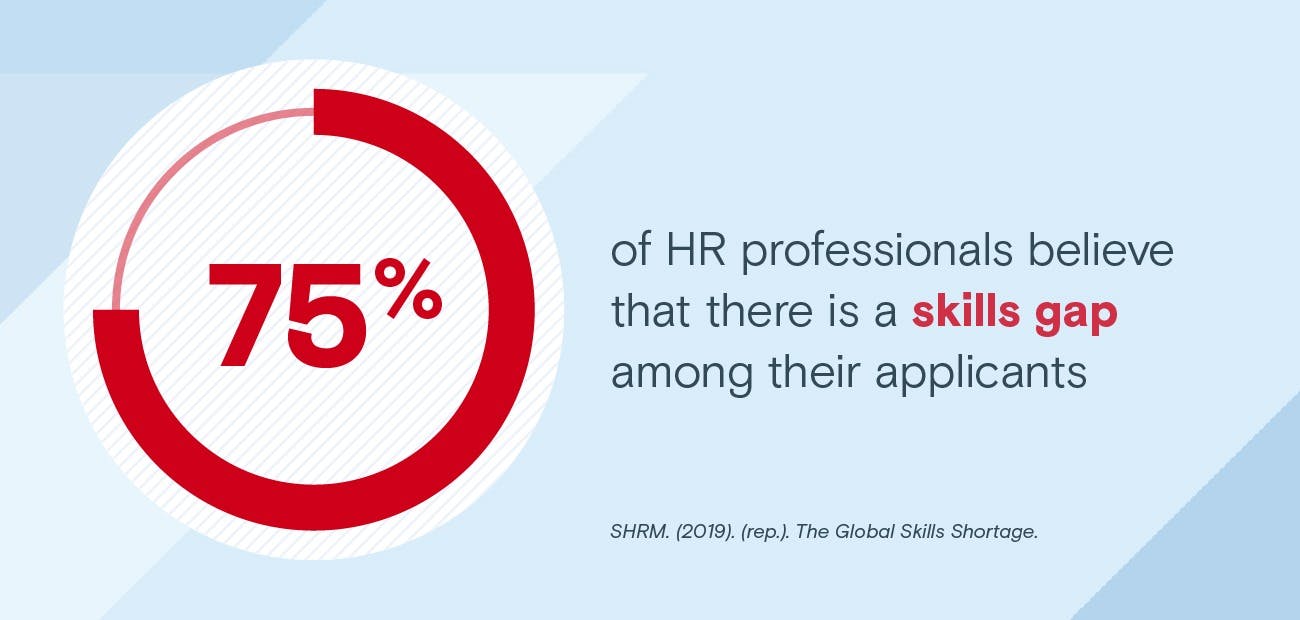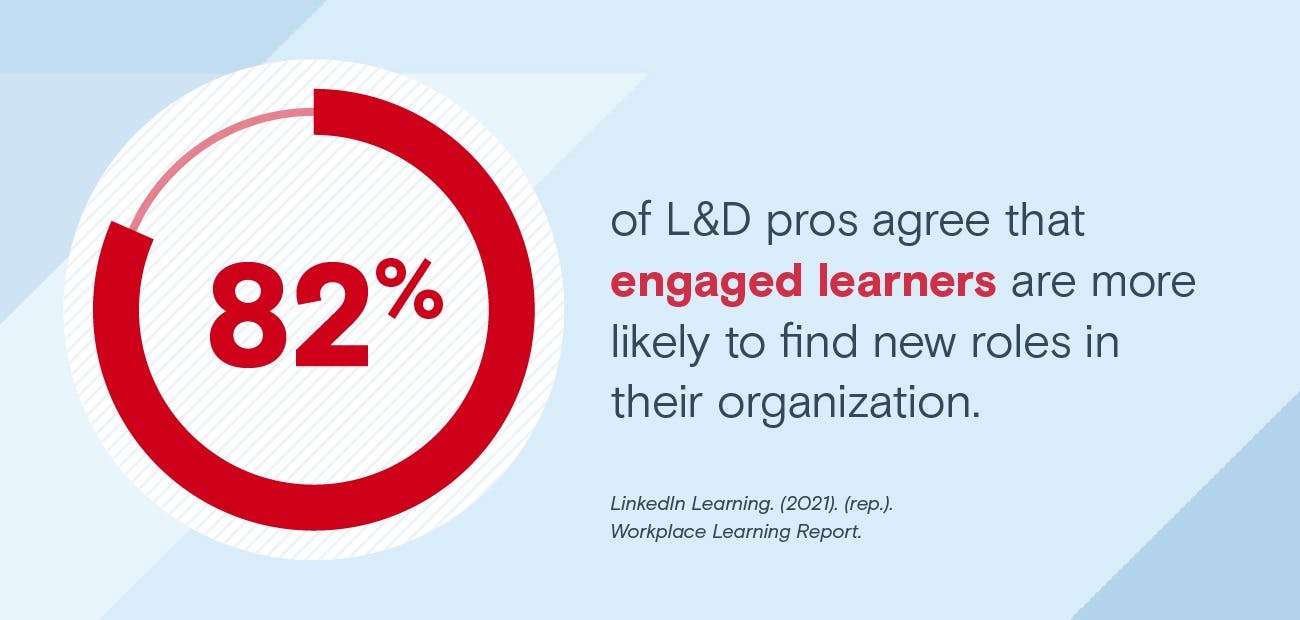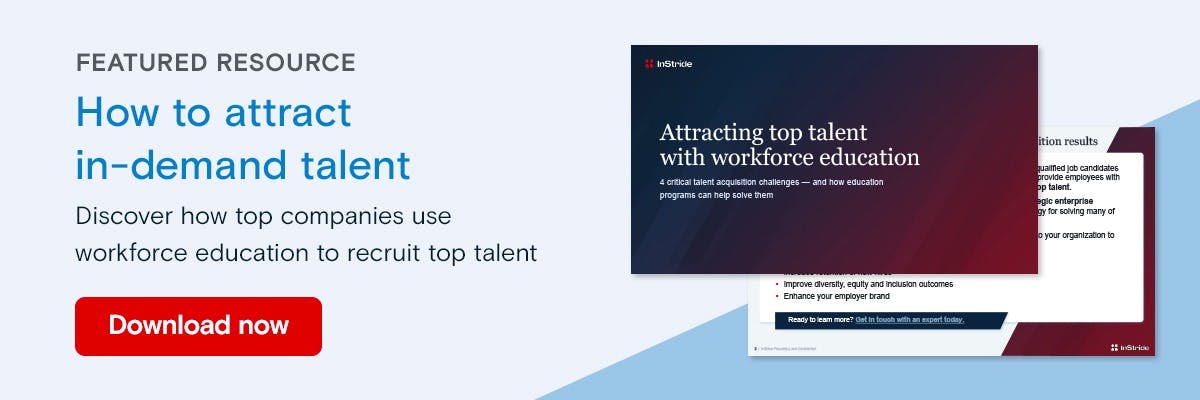Talent acquisition looks dramatically different than just a few years year ago. The global pandemic and diversity, equity and inclusion (DEI) movement have shaped (and accelerated) employee recruitment trends related to remote work, virtual recruiting, internal mobility, as well as upskilling and education options.
Leaders can gain a competitive edge in the war for talent by delivering lifelong learning opportunities that improve their company’s ability to attract, hire and retain their workforce.
Below we’ve compiled a list of talent acquisition statistics to help improve your overall employee recruitment strategies and results.
Top talent acquisition and recruitment statistics
- More than 90% of employers report they are hiring for new roles in 2021, as they continue to respond, recover and readapt in the new world of work. (iCIMS)
- 75% of HR professionals believe that there is a skills gap among their applicants. (SHRM)

- Employees are leveraging education to move into new roles, and managers approve. Over a third (35%) of employees globally have used employee learning programs to help them find opportunities in their organizations, and 91% of managers believe this can help close skills gaps on their teams. (LinkedIn)
- 66% of business leaders agree that strategic education programs attract new talent. (InStride)
- 50% of learning and development (L&D) professionals expect their recruiting budget to decrease this year while 66% anticipate their learning and development budget to increase or stay the same. (LinkedIn)
- 70% of US employees say they're at least somewhat likely to leave their current company and accept an offer with a new company that's known for investing in employee learning and development. (Harris Poll)
- By 2030, there will be a shortage of human talent, globally amounting to more than 85 million people. If this shortage is left unchecked, then it could result in a loss of $8.5 trillion in unrealized annual revenues. (Korn Ferry)
- 51% of L&D pros agree that internal mobility – tapping into internal talent pools – is more of a priority now than before COVID-19. Internal hires increased in April-August 2020 compared with the same time period in 2019, and now make up almost 20% of an organization’s workforce on average. (LinkedIn)
- 82% of L&D pros agree that engaged learners are more likely to find new roles in their organization. (LinkedIn)

Employer branding statistics
- 86% of Glassdoor users read company reviews and ratings before making a decision to apply for a job. (Glassdoor/Harris Poll)
- 72% of recruiting leaders worldwide agreed that employer brand has a significant impact on hiring. (LinkedIn)
- 46% of HR, procurement and C-suite leaders say a strong brand leads to stronger engagement and higher productivity. (Randstad)
- 96% of employer branding and recruitment specialists use social media. Instagram and LinkedIn are the most used social media platforms for employer branding. (Content Stadium)
Employee benefits statistics
- Almost all employees surveyed (94%) want their employers to ensure the benefits offered have a meaningful impact on their quality of life, like paying off student loan debt and offering more flexible work arrangements. (Randstad)
- The top two pieces of information job seekers look for when researching a company or looking at job ads are salary (67%) and benefits (63%). (Glassdoor)
- Companies that use benefits strategically experience better overall company performance (58% vs. 34%), above-average effectiveness in recruitment (19% vs. 8%), and higher retention than companies that don't (28% vs. 11%). (SHRM)
- The top reasons employees are looking or would consider leaving their company were “compensation” (52%), “career advancement” (43%), and “lack of recognition” (19%). (Achievers)
Company culture statistics
- When companies invested in corporate responsibility and company culture, their turnover reduced 50%, employee productivity increased by up to 13%, and engagement increased by up to 7.5%. (Project ROI)
- Nearly half (45%) of employees say leadership is “minimally” or “not at all” committed to improving company culture. Only 23% of employees call them “more than” or “very” committed. (Achievers)
- 56% of workers ranked a strong workplace culture as more important than salary, with more than three-in-four workers saying they’d consider a company’s culture before applying for a job there. (Glassdoor)
- Only 31% of HR leaders say their organizations have the culture they need to drive future business and just 21% say that their employees deeply trust company leaders. (Achievers)
Diversity recruiting statistics
- More than 3 in 4 employees and job seekers (76%) report a diverse workforce is an important factor when evaluating companies and job offers. (Glassdoor)
- Organizations with diverse management have 19% higher revenue when compared to those who have below-average leadership diversity. (BCG)
- Only 25% of organizations set gender diversity targets while creating their hiring strategy. (Women in the Workplace)
- 78% of HR professionals say that diversity in the workplace is impacting how they hire. (LinkedIn)
- The national GDP would increase $25 billion if just 1% more disabled people were hired. (Accenture)
- Nearly 90% of employers have a diversity recruiting strategy for the class of 2021. (NACE)
A strong talent acquisition strategy can help position a company to attract, hire and retain employee talent. But it all comes back to people. Recent trends have led to a more holistic, people-first approach that encompasses important elements including work-life balance, mental health, plus growth and learning opportunities for the exciting road ahead.
To learn more about the important role of education in creating an effective talent acquisition strategy, check out this e-book, Start with People: How to build a competitive advantage with education.


